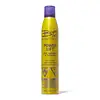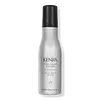What's inside
What's inside
 Benefits
Benefits

 Concerns
Concerns

 Ingredients Side-by-side
Ingredients Side-by-side

Water
Skin ConditioningHydrofluorocarbon 152a
Dimethyl Ether
SolventCorn Starch Modified
AbsorbentPolyquaternium-4
Hydrolyzed Wheat Protein
Skin ConditioningHydrolyzed Wheat Starch
Skin ConditioningPolysorbate 20
EmulsifyingParfum
MaskingCarbomer
Emulsion StabilisingTriethanolamine
BufferingTetrasodium EDTA
PEG-45 Palm Kernel Glycerides
EmulsifyingPPG-5-Ceteth-20
EmulsifyingPanthenol
Skin ConditioningBenzophenone-4
UV AbsorberMethylchloroisothiazolinone
PreservativeMethylisothiazolinone
PreservativeWater, Hydrofluorocarbon 152a, Dimethyl Ether, Corn Starch Modified, Polyquaternium-4, Hydrolyzed Wheat Protein, Hydrolyzed Wheat Starch, Polysorbate 20, Parfum, Carbomer, Triethanolamine, Tetrasodium EDTA, PEG-45 Palm Kernel Glycerides, PPG-5-Ceteth-20, Panthenol, Benzophenone-4, Methylchloroisothiazolinone, Methylisothiazolinone
Water
Skin ConditioningDimethyl Ether
SolventPolyimide-1
Hydrofluorocarbon 152a
Glycerin
HumectantPropylene Glycol
HumectantPolyquaternium-11
Butylene Glycol
HumectantPEG-45 Palm Kernel Glycerides
EmulsifyingBenzophenone-4
UV AbsorberIodopropynyl Butylcarbamate
PreservativeSimmondsia Chinensis Seed Oil
EmollientTetrasodium EDTA
Hydrolyzed Oat Protein
Skin ConditioningDiazolidinyl Urea
PreservativePanthenol
Skin ConditioningAloe Barbadensis Leaf Extract
EmollientPPG-5-Ceteth-20
EmulsifyingButylated Pvp
Parfum
MaskingHelianthus Annuus Seed Extract
Skin ConditioningPEG-12 Dimethicone
Skin ConditioningWater, Dimethyl Ether, Polyimide-1, Hydrofluorocarbon 152a, Glycerin, Propylene Glycol, Polyquaternium-11, Butylene Glycol, PEG-45 Palm Kernel Glycerides, Benzophenone-4, Iodopropynyl Butylcarbamate, Simmondsia Chinensis Seed Oil, Tetrasodium EDTA, Hydrolyzed Oat Protein, Diazolidinyl Urea, Panthenol, Aloe Barbadensis Leaf Extract, PPG-5-Ceteth-20, Butylated Pvp, Parfum, Helianthus Annuus Seed Extract, PEG-12 Dimethicone
Ingredients Explained
These ingredients are found in both products.
Ingredients higher up in an ingredient list are typically present in a larger amount.
Benzophenone-4 is a water-soluble chemical sunscreen.
It protects in the UV-B range, but is considered a secondary UV absorber. This means that it needs to be paired with other sunscreen ingredients to provide effective protection.
Typically, it's used in cosmetic products to protect them from deterioration caused by UV rays. This is why you'll find it in a lot of products that aren't sunscreens.
Learn more about Benzophenone-4This ingredient is also known by its brand name, Dymel-A.
It is a colorless gas and often used in aerosols.
We don't have a description for Hydrofluorocarbon 152a yet.
Panthenol is a common ingredient that helps hydrate and soothe the skin. It is found naturally in our skin and hair.
There are two forms of panthenol: D and L.
D-panthenol is also known as dexpanthenol. Most cosmetics use dexpanthenol or a mixture of D and L-panthenol.
Panthenol is famous due to its ability to go deeper into the skin's layers. Using this ingredient has numerous pros (and no cons):
Like hyaluronic acid, panthenol is a humectant. Humectants are able to bind and hold large amounts of water to keep skin hydrated.
This ingredient works well for wound healing. It works by increasing tissue in the wound and helps close open wounds.
Once oxidized, panthenol converts to pantothenic acid. Panthothenic acid is found in all living cells.
This ingredient is also referred to as pro-vitamin B5.
Learn more about PanthenolParfum is a catch-all term for an ingredient or more that is used to give a scent to products.
Also called "fragrance", this ingredient can be a blend of hundreds of chemicals or plant oils. This means every product with "fragrance" or "parfum" in the ingredients list is a different mixture.
For instance, Habanolide is a proprietary trade name for a specific aroma chemical. When used as a fragrance ingredient in cosmetics, most aroma chemicals fall under the broad labeling category of “FRAGRANCE” or “PARFUM” according to EU and US regulations.
The term 'parfum' or 'fragrance' is not regulated in many countries. In many cases, it is up to the brand to define this term.
For instance, many brands choose to label themselves as "fragrance-free" because they are not using synthetic fragrances. However, their products may still contain ingredients such as essential oils that are considered a fragrance by INCI standards.
One example is Calendula flower extract. Calendula is an essential oil that still imparts a scent or 'fragrance'.
Depending on the blend, the ingredients in the mixture can cause allergies and sensitivities on the skin. Some ingredients that are known EU allergens include linalool and citronellol.
Parfum can also be used to mask or cover an unpleasant scent.
The bottom line is: not all fragrances/parfum/ingredients are created equally. If you are worried about fragrances, we recommend taking a closer look at an ingredient. And of course, we always recommend speaking with a professional.
Learn more about ParfumPEG-45 Palm Kernel Glycerides isn't fungal acne safe.
We don't have a description for PPG-5-Ceteth-20 yet.
Tetrasodium EDTA is the salt formed from neutralizing ethylenediamine tetraacetic acid with sodium hydroxide. It is a chelating agent and used to prevent metal ions from binding to other ingredients. This helps keep the product and ingredients stable.
Tetrasodium EDTA comes as a white solid and is soluble in water.
Water. It's the most common cosmetic ingredient of all. You'll usually see it at the top of ingredient lists, meaning that it makes up the largest part of the product.
So why is it so popular? Water most often acts as a solvent - this means that it helps dissolve other ingredients into the formulation.
You'll also recognize water as that liquid we all need to stay alive. If you see this, drink a glass of water. Stay hydrated!
Learn more about Water